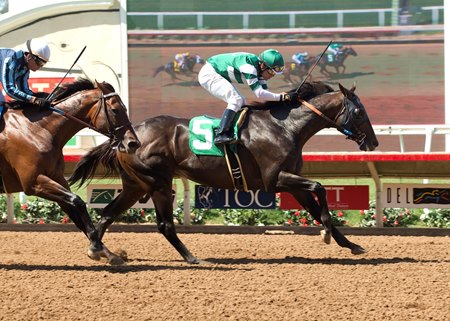Four jockeys, including leading rider Santiago Gonzalez, were given three-day suspensions for riding infractions at Santa Anita last week. The name is Santiago Gonzalez and he is making some inroads into the Southern California jockey colony quickly, quietly, but eye catching. Through last week, Gonzalez ranked 59 th in the country with 51 wins from 372 mounts. He won with 11 of his first 63 at Del Mar to be in the top 5 in a very good jockey colony.

By Alberto Garcia
Opening Day at the Del Mar racing season on Wednesday saw several Latino jockeys ride into the Winner’s Circle, continuing a growing trend of riders from Latin countries dominating the sport of kings.
On Wednesday, the jockey with the most wins on the day was Rafael Bejarano, a 35-year old rider from Peru, taking the win in four races. Bejarano has over 3,000 wins under his belt, having won a record seven races in a single day in 2004.
But Bejarano was not the only Latino to win on Del Mar’s opening day. Mexican-born Israel Ocampo rode Geologist to win the second race, and T.J. Pereira from Brazil won aboard Bowies Hero in the eighth race of the day.

Other Latino jockeys riding Wednesday included Daniel P. Vergara, Mario Gutierrez, Norberto Arroyo, Jr., Victor Espinoza, Santiago Gonzalez, and Agapito Delgadillo.
Nationally, Latino jockeys have won major horse races and have become some of the highest earners in the sport. So far, five Latino jockeys have been inducted into the National Museum of Racing.
In 2010, seven of the top 10 jockeys based on earnings were Latinos, including Rafael Bejarano, who that year earned over $14 millions in race purses.
Although jockeys work for the owners of the horses, the rider usually earns about 10 percent of the winnings, which can amount to millions of dollar per year.


For example, John R. Velázquez, a Puerto Rican-born jockey, has become the highest earning jockey of all time, and has inducted into the racing Hall of Fame in 2012.
Velazquez has won thirteen Breeders’ Cup and four Triple Crown races including winning the Kentucky Derby in 2007 and again in 2011.
In 2011, Velázquez earned more than $4 million for himself, and Mexico City’s Víctor Espinoza made over $2.8 million.
Dominican jockey Joel Rosario has also become a major player in horse racing. In 2011, Rosario earned more than $5.5 million a year. He became a professional jockey at 14 years old, and earned his first win in July 2000. In 2006, he moved to the United States, and just four years later, rode Make Music For Me to a fourth place finish at the 2010 Kentucky Derby.
One of the highest profile Latino jockeys in the past few years is Mexican Victor Espinoza, who rode American Pharoah to win the Triple Crown in 2015. His wins at the Kentucky Derby, the Preakness Stakes, and the Belmont Stakes made him the first Triple Crown winner since 1978. In that year, Cuban-born Laz Barrera won the Triple Crown aboard Affirmed.
Latinos already dominate the horse racing world and, with more entering the system each year, the future of the sport seems squarely in the hands of Spanish speakers.
“If horses could talk, they would surely speak Spanish,” said Bob Baffert, the trainer of Triple Crown winner American Pharoah.
Gary Bergsrud has been around horses his whole life. After watching his father train and run horses in Devils Lake, North Dakota, he knew he wanted to own horses one day. Bergsrud met his wife and partner Brenda (pictured above with jockey Santiago Gonzalez) at Assiniboia Downs in Winnipeg, Canada. He owned horses there and she was working for a trainer at the time. The couple went on to own horses together and include their son, T.J. Bergsrud, to manage their horses as well.
After purchasing horses for a few years, the Bergsrud decided to breed and raise their own. “The horses that we had been buying just didn’t work out and we thought we could raise better horses,” he said. Recent success has proven them right.

In July of 2007, Bergsrud came to Canterbury Park after being persuaded by his friend and fellow horse owner Bernell Rhone. “We wanted to run better horses and needed a higher level track to race them at,” Bergsrud said. His first horse to run at Canterbury Park, Alacazar, won and Bergsrud and his family have been entering their horses here ever since.
Sandra Sweere has been training the Bergsrud’s horses for the past five years. “Sandra has been very good for us and always does her best to meet our horses’ needs,” Gary said. The couple currently own four horses at Canterbury Park and commute from their home in Rolla, North Dakota to watch them race.
Bergsrud says that when owning a horse at any level it is important to “stay on top of things.” He adds that “it can be very easy to get a little behind on the management side of things, but if you are dedicated enough it will all work out.”
To stay on top of things, Bergsrud checks in on the horses at least two times a week to see how they are doing. “We have little time to do anything besides taking care of our horses and that’s the way we like it,” Bergsrud said.
Santiago Gonzalez Jockey Santa Anita
A favorite memory that Bergsrud has is seeing Pinup Girl win the $50,000 Lady Slipper Stakes race at Canterbury Park earlier this meet. “She and Santiago Gonzalez had a great ride here and we expect a big year for her,” he said.
Santiago Gonzalez Jockey
Bergsrud’s favorite part about breeding his own horses is having the chance to see them develop and watch them run. “The whole process can take a lot of time and energy, but it is all worth it when you see your horse win,” he said.